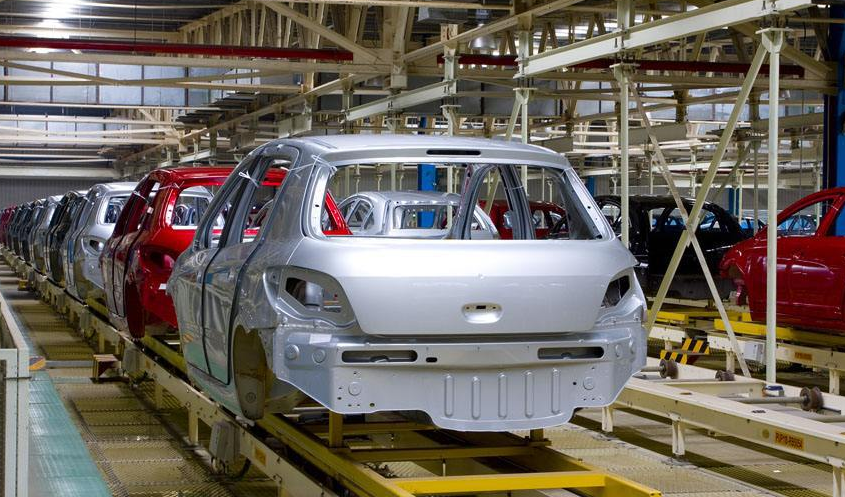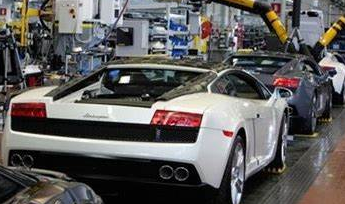Development history, current situation and future trend of automobile industry
America
In 1909, the Ford Company of the United States opened a new era of automobile manufacturing by producing the Model T car, which is regarded as the most important automobile invention of the 20th century. In 1913, Ford Company created the world's first automobile assembly line, which greatly improved the efficiency of automobile manufacturing, reduced production costs, and laid the foundation for the popularity of automobiles in the United States.
The United States annual output of 1 million cars in 1916, the annual output of cars exceeded 2 million in 1920, and in 1929, on the eve of the Great Depression in the United States, the annual output of cars reached 5 million, becoming the world's first automobile manufacturing power. The automobile industry has become the largest industry in the United States, and the United States has become the first country in the world to take automobile manufacturing as a pillar industry.
The rapid development of the American automobile industry gave birth to the three major automobile manufacturers in the United States, namely General Motors, Ford and Chrysler, and the sales of the three major automobile giants accounted for more than 90% of the total sales in the United States. The headquarters of the three major automobile giants gathered in Detroit, the peak of the Detroit population of more than 1.8 million, automobile production accounted for more than 80% of the global automobile production, the prosperity of the automobile industry makes Detroit become the United States and even the global automobile manufacturing center, an industry achievements a city.

Germany
Germany is the birthplace of the modern automobile and the country with the longest history of automobile manufacturing. Since the German inventor Carl Benz invented the first automobile in 1886, the German automobile industry has gone through more than 120 years of development.
In the 1920s, the United States automobile industry developed rapidly, and in addition to meeting the needs of its own people, it also exported a large number of cars to European countries. After 1930, in order to protect their national industrial development, European countries began to raise tariffs on American auto imports, forcing the three major American auto giants to establish car factories in the local area and promote the development of the European auto industry.
Affected by the two World Wars, it was not until the 1950s that the German automobile industry really entered a period of rapid development. In 1950, the annual production of automobiles in the Federal Republic of Germany reached 300,000. The Volkswagen Beetle was popular in Germany and Europe with its low price and was exported to many countries, including the United States. In 1960, Germany produced 2 million cars a year, surpassing the United Kingdom, becoming the largest automobile producer and exporter in Europe, becoming the second largest automobile manufacturer after the United States. In 1970, the annual output of automobiles in European countries reached 10.378 million, surpassing the United States, and the center of the world automobile industry gradually transferred from the United States to Europe.
The development of the German automobile industry has led to the birth of a number of world-renowned car manufacturers and auto parts manufacturers, car manufacturers have Daimler-Benz, Volkswagen, BMW, Porsche, etc., first-class parts manufacturers have Bosch, ZF, Continental and so on. Stuttgart, Germany, brings together major automobile manufacturers and first-tier parts suppliers, as well as second - and third-tier small professional suppliers in various automotive product segments, forming a huge automotive supply chain network, Stuttgart is recognized as one of the best automotive industry clusters in the world.

Japan
Japanese automobile manufacturing began with Shintaro Yoshida. In 1904, Shintaro Yoshida established Japan's first automobile manufacturing company, Tokyo Motor Works, which is now Isuzu Motor Company, and three years later produced Japan's first fuel car "Taikoo I". The Japanese government attaches great importance to the development of the automobile industry and has formulated a series of policies to promote the process of Japanese automobile localization.
In the two decades after World War II, Japan promoted high-quality, low-energy and affordable cars according to the national conditions of resource shortage. The Japanese automobile industry entered a period of rapid development. In 1961, the annual output of Japanese automobiles exceeded Italy and ranked fifth in the world, surpassed France and ranked fourth in 1965 and surpassed Britain and third in 1966. In 1968, it overtook Germany to take second place.
In the 1970s, the global oil crisis broke out, high-power and large cars in Europe and the United States were hit hard, and Japan's high-quality, low-energy and affordable cars swept the world. In 1980, Japan's annual automobile production exceeded the 10 million mark for the first time, beating the United States to become the world's first automobile manufacturer. In 1987, Japan's annual automobile production accounted for 26.6% of the world's total automobile production, the United States and the four European countries were 23.7% and 24.8%, respectively, and the world's automobile industry center was transferred to Japan.
Japan gave birth to Toyota, Nissan, Honda, Mazda, Suzuki and other car manufacturers, and gave birth to world-renowned auto parts suppliers such as Denso and Aisin Seiji. Japan's Aichi prefecture gathers the world's largest automobile manufacturer Toyota, first-level supplier Denso, as well as Mitsubishi, Suzuki, Volkswagen Group and other major automobile manufacturers, a total of 14 car manufacturing plants in the area, becoming one of the most industrialized regions in Japan, but also the world's well-known auto parts manufacturing, car assembly in one of the comprehensive automobile industry cluster.

Korea
The first car manufacturer in Korea was Kia Motors, which was founded in 1944. In the 1960s, South Korea adopted the form of imported parts for assembly and began the road of national automobile development. In the 1970s, the Korean government implemented the automobile localization policy and introduced foreign technology to independently develop and produce automobiles. The automobile localization policy enabled the rapid development of the Korean automobile industry. In 1985, the annual output of Korean automobiles was 370,000, in 1990, 1.32 million, and in 1995, 2.54 million.
South Korea's local car market space is limited, the South Korean government to implement the automobile export-oriented strategy, starting from the 1980s, South Korean cars with a lower price strategy has entered the United States, the European market, in 1995, South Korean car exports reached 1.1 million. In 1996, the annual output of South Korea reached 2.83 million vehicles, becoming the world's fifth largest automobile manufacturer and the sixth largest automobile exporter, and South Korea has become a veritable automobile manufacturing power.
South Korea's auto industry has given birth to automakers such as Hyundai, Kia, Daewoo and Ssangyong, as well as world-renowned parts suppliers such as Mobis, and the auto industry has become a pillar industry of South Korea. It took 30 years for the United States to become an automobile industry power, nearly 20 years for Germany and Japan, and 17 years for South Korea to become an automobile manufacturing power, which is worth learning and learning from.

China
In 1929, Zhang Xueliang invested and prepared the Mingsheng factory, which trial-produced the first automobile in China. In the following 20 years, due to war factors, China's automobile industry was in a state of stagnation. From the founding of New China to the 1980s, China's automobile industry focused on the development of trucks and buses, and the "Dongfeng brand" truck independently developed by the second Automobile Factory reached an annual output of 100,000 vehicles in the mid-1980s, which was a miracle under the conditions of China at that time.
In the mid-1980s, the central government decided to establish a modern car industry. In 1984, Beijing Automotive Industry Corporation and Chrysler Corporation jointly invested and established China's first vehicle manufacturing company, and China's automobile industry entered the stage of foreign joint ventures, and a large number of joint ventures were born in China.
In the late 1990s, the central government decided to vigorously revitalize the automobile manufacturing industry and explicitly encouraged cars to enter the household. Subsequently, influential automobile manufacturing enterprises such as Chery, Great Wall and Geely were born in China, and China's automobile industry entered a period of rapid development. In 2009, China's annual automobile production reached 13.79 million units, ranking first in the world. Since China became the largest automobile manufacturing country in the world, the annual automobile production has continued to grow. In 2019, the annual automobile production reached 25.72 million units, ranking first in the world continuously.

From the perspective of the development of the global automobile industry, we can draw the following conclusions:
1, the automobile industry has a hundred years of history, the global automobile industry center has experienced three major transfers, each industrial transfer has driven a country, the national economic development, the national industrial policy plays a vital role in the development of the automobile industry.
2, a country, national automobile industry development has gone through: imitation learning, localization, branding process, automobile industry is a comprehensive industry, with industrial cluster effect, on behalf of the country, national industrialization level.
The development of the industry follows the objective development law: introduction period, growth period, maturity period, decline period, and the cycle repeats. From the perspective of the development of the automobile industry, the automobile industry after nearly a hundred years of brilliant development, is currently in a mature period, in recent years, there are signs of recession, where will the 100-year automobile industry go in the future?
The government's industrial policy plays a crucial role in the future development of the automobile industry. In the face of a century of great changes in the automobile industry, the United States, Europe, Japan, China and other major automobile market countries have listed pure electric vehicles as the leading direction of the future development of automobiles, and through the development of a series of industrial policies to promote the development of pure electric vehicles.

Eu: In April 2019, the EU issued the "2019/631 document", which stipulates that the CO2 emissions of newly registered passenger cars in 2025 and 2030 will be reduced by 15% and 37.5% respectively on the basis of 2021, relative to the previous standard, the new policy is more stringent, and the electric transformation is the only way out.
1.China: In 2010, new energy vehicles as one of China's strategic emerging industries, the government has issued a comprehensive incentive policy, from the research and development link government subsidies, double points in the production link, financial subsidies in the consumption link, purchase tax exemption, use link unlimited license purchase, etc., the policy covers the entire life cycle of new energy vehicles.
2.Japan: As a country with a lack of resources and a high degree of external dependence on energy, Japan has long attached importance to the development and application of new energy vehicles, and in 2009, the Japanese Ministry of Economy, Trade and Industry proposed the "EV/PHEV city" initiative, the construction of electric vehicle demonstration areas in 18 regions, and promoted the full popularization of EV/PHEV from point to point, and has introduced a series of incentive strategies. It includes three aspects: strategic planning, financial subsidies and tax relief.
3.United States: During the Obama administration, promoting the development of new energy vehicles is an important aspect of energy policy, and a series of new energy policies and vehicle fuel standards have been formulated. Through the "Energy Independence and Security Program", tax breaks and bank loans are given to new energy vehicle manufacturers and new energy auto parts manufacturers.
Major auto market countries clear fuel vehicle ban schedule and new energy vehicle development goals, from the official disclosure data of various countries, new energy vehicles accounted for the proportion of new car sales, the EU 2030 35%, China 2025 25%, 2030 40%, Japan 2030 20%-30%, the United States 2025 15%.

Through the above analysis, we can draw the following conclusions:
1. From the perspective of the development status of the automobile industry, the automobile industry is in the mature stage and has the phenomenon of decline. However, the emergence of the demand for new energy vehicles will deconstruct the ceiling of industrial development and the automobile industry will enter a new industrial cycle.
2, from the perspective of national new energy vehicle policies, major auto market countries have launched industrial support policies to promote the development of new energy vehicle industry, the European Union is the most active, followed by China, followed by Japan, and the United States is conservative.
3, from the perspective of the development goals of new energy vehicles in various countries, the proportion of new energy vehicles in new car sales is expected to reach more than 30% in 2030, and the market prospect of new energy vehicles is broad.
- EMERSON
- Honeywell
- CTI
- Rolls-Royce
- General Electric
- Woodward
- Yaskawa
- xYCOM
- Motorola
- Siemens
- Rockwell
- ABB
- B&R
- HIMA
- Construction site
- electricity
- Automobile market
- PLC
- DCS
- Motor drivers
- VSD
- Implications
- cement
- CO2
- CEM
- methane
- Artificial intelligence
- Titanic
- Solar energy
- Hydrogen fuel cell
- Hydrogen and fuel cells
- Hydrogen and oxygen fuel cells
- tyre
- Chemical fiber
- dynamo
- corpuscle
- Pulp and paper
- printing
- fossil
- FANUC
- Food and beverage
- Life science
- Sewage treatment
- Personal care
- electricity
- boats
- infrastructure
- Automobile industry
- metallurgy
- Nuclear power generation
- Geothermal power generation
- Water and wastewater
- Infrastructure construction
- Mine hazard
- steel
- papermaking
- Natural gas industry
- Infrastructure construction
- Power and energy
- Rubber and plastic
- Renewable energy
- pharmacy
- mining
- Plastic industry
- Schneider
- Kongsberg
- NI
- Wind energy
- International petroleum
- International new energy network
- gas
- WATLOW
- ProSoft
- SEW
- wind
- ADVANCED
- Reliance
- YOKOGAWA
- TRICONEX
- FOXBORO
- METSO
- MAN
- Advantest
- ADVANCED
- ALSTOM
- Control Wave
- AB
- AMAT
- STUDER
- KONGSBERG
- MOTOROLA
- DANAHER MOTION
- Bently
- Galil
- EATON
- MOLEX
- Triconex
- DEIF
- B&W
- ZYGO
- Aerotech
- DANFOSS
- KOLLMORGEN
- Beijer
- Endress+Hauser
- MOOG
- KB
- Moxa
- Rexroth
- YAMAHA
- Johnson
- Westinghouse
- WAGO
- TOSHIBA
- TEKTRONIX


Email:wang@kongjiangauto.com



































































































































